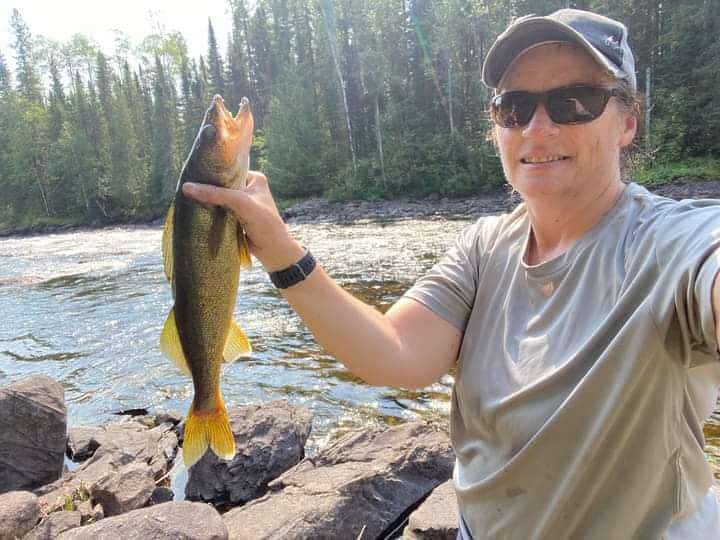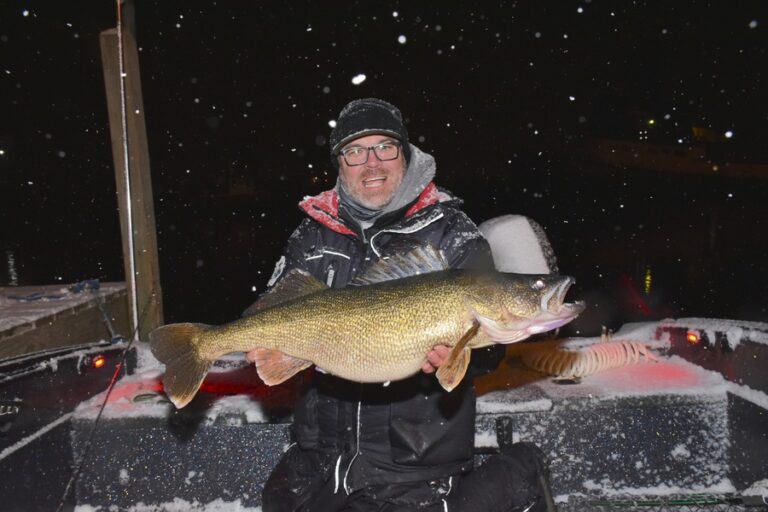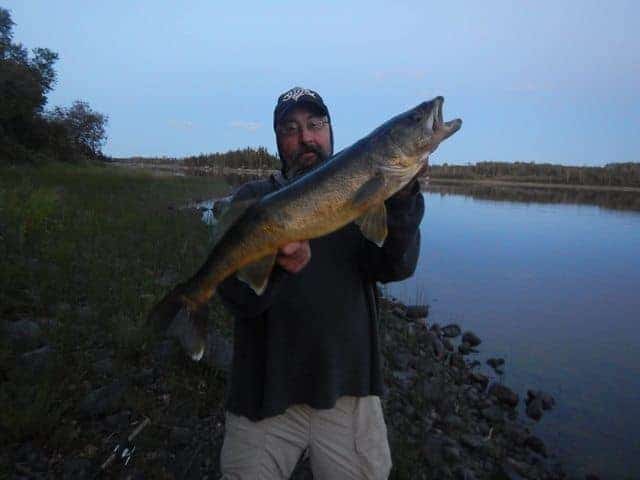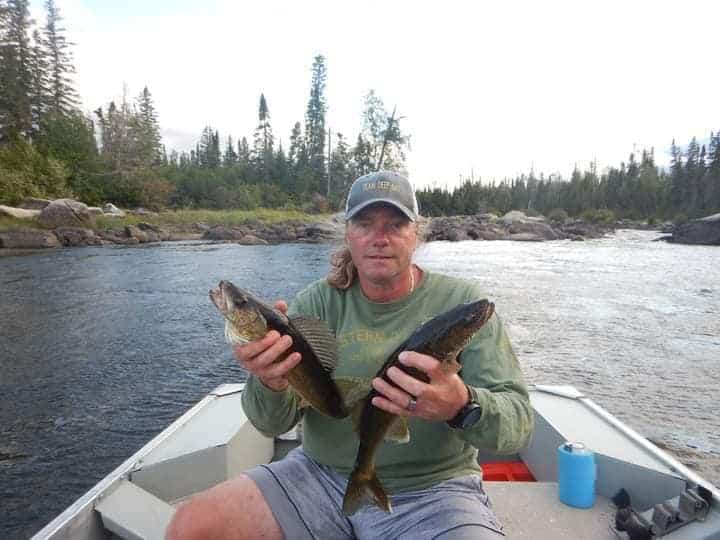Walleye Fishing in Snow (A Complete Guide)
Fishing for walleye on snowy days can be exciting but you need to have the right approach dialed in to catch fish.
Walleye fishing on snowy days can be good as these fish often seek deeper, warmer waters and become more active due to reduced light penetration from overcast skies. After the snow stops, the bite can really shut down.
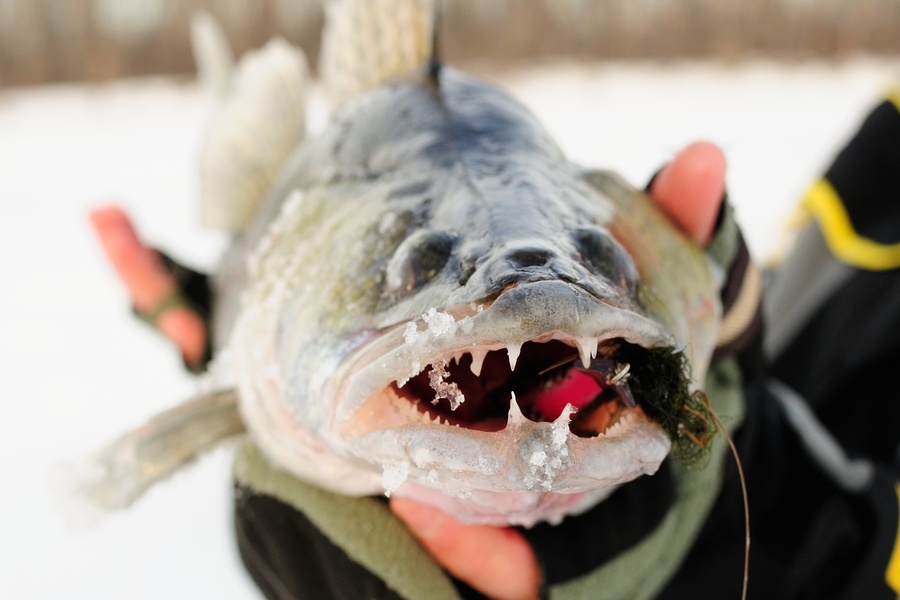
Table of Contents
Walleye Fishing in Snow: What to Expect?
To catch walleye on snowy days, focus on deeper areas and structure like humps, drop-offs, and ledges. These zones will offer more stable, warmer water on freezing days.
Use lures that are bold and easy to see in low visibility conditions, such as bright oranges or neon greens. Soft plastics and jigs tipped with live bait like minnows or nightcrawlers can be particularly effective. Slow-moving, deliberate presentations are crucial as walleye are less likely to chase fast-moving baits in colder, snowy conditions.
Keep a close eye on the water temperature and clarity, as these factors significantly influence walleye behavior. Snowy conditions often lead to changes in water temperature and can affect visibility underwater, impacting how walleye feed and where they position themselves.
Walleye fishing on snowy days can be a mixed bag. Weather changes and approaching precipitation can heat up the bite but dropping temperatures can chill the action. Expect walleye to drop down in water depth to find warmer water. Look at around deeper structure like humps and drop-offs.
The best times for fishing are before lighter snowfall or during a snowstorm, when walleye may be more active and feeding. During these times, walleye move to slightly shallower areas, particularly near structures that offer protection and potential feeding opportunities.
Click here to learn how weather impacts walleye fishing. To learn how to catch walleye on sunny days, check out this guide. To learn how to catch walleye on cold days, check out this guide.
Walleye Behavior in Snowy Conditions
Generally speaking, any type of weather break or change can turn on the walleye bite. Snow can go both ways but I like fishing under the snow. Walleye will push to shallower waters and usually feed a little better.
Before Snow
Just like rain, walleye fishing in the snow usually picks up before the snow starts falling. I love fishing before a snow through the ice. Try tip-ups with shiners or dead suckers as well as jigging. If open water fishing, drift fishing with bait or Gulp! Alive! baits can be dynamite. Look for mid-depth water around humps, sunken timber, and ledges.
Tip: Try a bait in a minnow, ghost, or perch color. These baits can be incredible before a snow.
During Snow
Fishing can be excellent during the snowstorm itself. Look for walleye to move up from the deep into mid-depth water and into shallower water. I like to focus on water 12-20 feet deep. Focus around drop-offs, ledges, and humps. The temperature changes and reduced light during snowfall can really ramp up feeding.
After Snow
You can do well both ice fishing and from a boat after a snow event. I have caught a lot of slot-sized walleye after a solid snow. The trick is to find larger pockets of fish suspended off the bottom. Look for walleye need deep weed edges, dropoffs, and ledges. I wouldn’t recommend moving baits but bottom bouncers, drifting bait, and ice jigging can be very effective.
Locating Walleye on Snowy Days
Lakes: In snowy conditions, walleye are typically found in the deeper zones of lakes. Target areas near drop-offs and deep weed lines, with preferred depths usually ranging between 20 to 40 feet, depending on the lake’s characteristics.
Rivers: In rivers, look for walleye in deeper pools and areas with reduced current. Depths between 15 to 25 feet can be productive, especially around bends and submerged features. The snow can turn on an inactive bite or shut down an active bite on rivers.
Structure & Cover
Table: Walleye Features on Snowy Days
| Feature | Description | Preferred Depths | Why Attractive on Snowy Days |
|---|---|---|---|
| Deep Pools | Deeper areas in rivers offering stable conditions. | 15-25 feet | Stable temperature and reduced current. |
| Submerged Trees | Provide cover and attract baitfish. | 20-40 feet | Protection from elements and feeding opportunities. |
| Rock Formations | Offer hiding spots and ambush points. | 20-40 feet | Stable environment and prey availability. |
| Weed Lines | Edges where deeper weeds meet open water. | 15-30 feet | Protection and access to food sources. |
Seasonal Guide
Fall
If it snows in fall, this often triggers better walleye fishing. Walleye feeding activity will spike. Look for them around deeper weed edges and long tapering points. Moving baits like jerkbaits, crankbaits, and spoons are great choices.
Winter
Snowy days in winter offer great chances for active feeding walleye. Focus on deep water structures and use slower, more deliberate techniques. Jigging with live bait or using spoons and jigging raps can be effective.
Post-snowstorm periods are particularly good for fishing, as walleye may be more active and feed aggressively after a period of low activity. Trying fishing during and immediately after a good snowfall.
Spring
Late season snowfall in spring can also start some nice walleye fishing. This is especially true after last ice as walleye stage in shallow northern bays. Throw jigs and spoons near deeper weed edges and creek mouths. Fishing will be best right before and during the snow.

Tackle Recommendations
Opt for higher visibility mainline like dark green braid to allow for better line control but use a long fluorocarbon leader to your bait. Walleye can still see very well on snowy days so I recommend a leader length of 10+ feet.
After the snow starts, use larger baits as walleye will be more willing to chase larger meals. If the water is gin-clear though, downsize our bait size and choose natural colors like ghost, shad, or perch mimic colors.
Back to the fishing line, braid will handle freezing temperatures and withstand ice abrasion on your rod eyelets better. Braid is also great because it offers unparalleled sensitivity and strength. A 10+ foot fluorocarbon leader is required though.
Tip: Seaguar Red or Blue Label are excellent options for sharp-eyed walleye. These are my two favorite fluorocarbon lines for walleye.
Snowy Day Walleye Fishing Tips
- Use Vibrant Lures: Brightly colored lures or those that glow can be more effective on snowy days, as they stand out in murky, overcast conditions.
- Slow Down Your Presentation: In colder waters, walleyes tend to be less active. Slowing down the retrieval speed of your lure can make it more appealing.
- Monitor Barometric Pressure: Walleyes are sensitive to changes in pressure; a dropping barometer often triggers more feeding activity.
- Focus on Prime Times: Fish during low-light conditions, such as dawn and dusk, when walleyes are most active, especially on snowy, overcast days.
- Use Smaller Baits: In colder water, walleyes’ metabolism slows down. Smaller baits can be more effective as they match the walleyes’ reduced appetite.
- Fish Near the Bottom: Walleyes often stay close to the bottom in colder weather, so position your bait or lure accordingly.
- Utilize Live Bait: Live minnows or worms can be more enticing than artificial baits in cold water conditions, as their natural movement attracts walleyes.
- Adjust to Water Clarity: In stained or murky water caused by snow runoff, use lures that create vibration or noise to help walleyes locate them.
- Seek Out Warm Water Inflows: Areas where warmer water enters a lake or river can attract walleyes in cold weather.
- Experiment with Jigging Techniques: Vertical jigging can be effective in enticing bites from lethargic walleyes.
Conclusion
Walleye fishing on snowy days can be effective as these fish often seek deeper, warmer waters and become more active due to reduced light penetration from overcast skies. Key strategies include focusing on deeper areas with structures like humps and drop-offs, using bold-colored lures and slow, deliberate presentations, and being mindful of changes in water temperature and clarity.
Fishing can be particularly good before and during snowfall, as walleyes tend to move to shallower areas and feed more actively, but post-snow conditions require targeting walleyes near deeper structures with techniques like bottom bouncing and ice jigging.
Frequently Asked Questions
Best Bait and Lure Choices for Snowy Conditions.
In snowy conditions, walleyes respond well to bright and glowing lures due to reduced visibility. Jigs tipped with live minnows, spoons, and ice fishing lures in vibrant colors or with reflective surfaces are effective. Soft plastics that mimic the natural prey of walleyes can also be successful, especially when fished slowly to match the walleyes’ reduced metabolism in cold water.
Impact of Snowfall on Walleye Behavior and Fishing Success:
Snowfall often leads to overcast conditions and reduced light penetration, which can make walleyes more active during daytime hours. However, snow runoff can affect water clarity and temperature, potentially causing walleyes to move to deeper areas or seek clearer waters. Anglers might need to adjust their tactics, focusing on deeper zones and using lures that are visible or produce vibrations in murkier waters.
Locating Walleyes in Snowy Weather:
Locating walleyes during snowy weather requires understanding their behavior in cold conditions. They often move to deeper areas or locations with structures like drop-offs and underwater channels. Using a fish finder can significantly aid in locating these fish. Also, areas with inflowing warmer water can be hotspots for walleye activity in cold weather.
Effective Techniques for Catching Walleyes in Cold and Snowy Conditions:
Slow retrieval and jigging are effective techniques in cold, snowy conditions. Walleyes are less active in cold water, so a slow-moving bait is more appealing. Vertical jigging near the bottom or in areas with structures can entice walleyes to bite. Additionally, anglers should experiment with varying depths and stay patient, as walleyes may take longer to strike in colder water.

